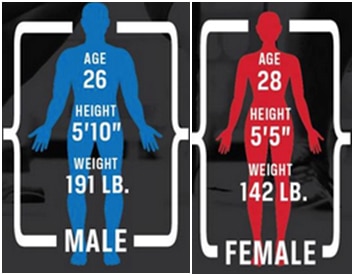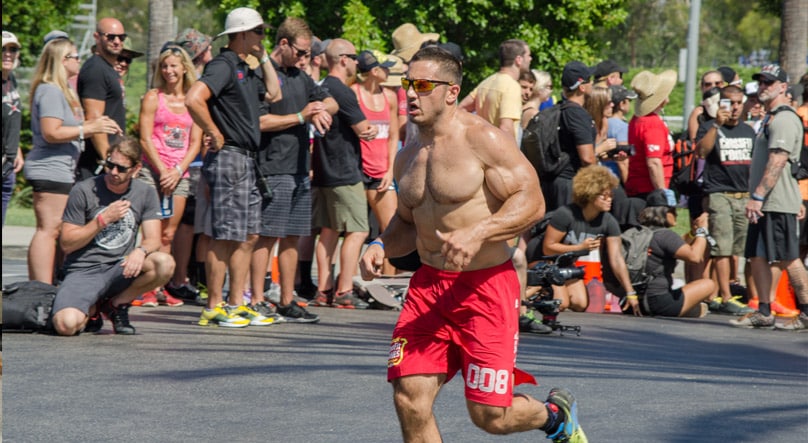In almost every competitive sport in which an athlete is required to move an external load—be it metal or flesh—weight classes play a role. Boxing, MMA, powerlifting, strongman, judo and Olympic Weightlifting all utilize weight classes. Even triathlons, which typically separate competitors by age, have two weight divisions for men over 200lbs (Clydesdale division) and women over 150lbs (Athena division). You wouldn’t expect a 150lb Olympic Weightlifter to out-lift a 200lb. competitor, nor would you expect a flyweight boxer to compete with a heavyweight. The governing bodies of those sports don’t think that huge disparities in weight create a level playing field—and they’re right.
But the idea of weight divisions at the CrossFit Games will probably never be entertained. Why? Because it goes against the ethos of the CrossFit Games—to find the fittest man and woman on earth. And to become the fittest, you have to be well rounded in every area of your game—regardless of how heavy, light, tall or short you are. The programming of the Games favors the “all rounder” and punishes the “specialist”. So while bigger athletes might excel in the heavy barbell events, they could also be exposed in endurance events that favor smaller athletes, and vice versa. That’s why Games athletes seek to be as balanced as they can be. It’s entirely possible that someone could win the Games without placing 1st in a single event by consistently finishing in the top 10-15 in every event.
But even though the purpose of the Games—and CrossFit in general—is to have balanced tests of fitness, some Games competitors don’t think the tests are equal for all competitors. Games legend Chris Spealler, at 5’5” and 145lbs, routinely battled against men far taller and heavier during his seven appearances at the CrossFit Games. “Speal” has often spoken of how bigger guys with existing strength bases that come into CrossFit have a natural advantage, as they are quickly able to build up their cardiovascular endurance. Take Mat Fraser, who came into the sport after spending two years training as an Olympic Weightlifter at the Olympic Training Center in Colorado Springs. Fraser qualified for his first Regionals after just 8 months of full CrossFit experience in 2013, and finished 2nd at the Games last year. Spealler has said that for smaller athletes, building a Games-level strength base can take a lifetime. In fact, he believes that the days of the smaller athlete qualifying for the Games might be numbered.
And that brings up an interest point. In most professional sports, there is a definite body ‘type’ that, over the years, has evolved to become the norm. In basketball, for example, there has been a sporting ‘natural selection’ that has culminated in the average NBA player being 6’7”—which makes sense when you consider the object of the game is to put a ball in a hoop that’s 10 feet tall. Height and length is valued in basketball, just as it is in gymnastics—albeit at the other end of the spectrum. But is there a certain body type that is favored for success in CrossFit? According to the statistics, it appears that there is.
The earliest statistical data we have for a full list of CrossFit Games competitors comes from 2009, the final year the Games were held on the Ranch in Aromas, CA, where the competition began in 2007.
Jump to:
- Male Top 5
- 160lbs and below
- 161lbs to 180lbs
- 181lbs to 200lbs
- Over 200lbs
- Female Top 5
- 130lbs and below
- 131lbs to 150lbs
- 151lbs to 160lbs
- Over 160lbs
- Male Top 5
- 160lbs and below
- 161lbs to 180lbs
- 181lbs to 200lbs
- Over 200lbs
- Female Top 5
- 130lbs and below
- 131lbs to 150lbs
- 151lbs to 160lbs
- Over 160lbs
- 160lbs and below
- 161lbs to 180lbs
- 181lbs to 200lbs
- Over 200lbs
- 130lbs and below
- 131lbs to 150lbs
- 151lbs to 160lbs
- Over 160lbs
Male Top 5
Mikko Salo: 5’7”, 176lbs
Tommy Hackenbruck: 6’1”, 195lbs
Moe Kelsey: 6’2”, 225lbs
Steve Willis: 6’2”, 205lbs
Jason Khalipa: 5’9”, 205lbs
160lbs and below
9 athletes
161lbs to 180lbs
23 athletes
181lbs to 200lbs
28 athletes
Over 200lbs
13 athletes
Average weight of a male athlete at 2009 CrossFit Games: 184lbs
Female Top 5
Tanya Wagner: 5’6”, 145lbs
Charity Vale: 5’2”, 123lbs
Carey Kepler: 5’8”, 137lbs
Kristan Clever: 5’2”, 130lbs
Lindsey Smith: 5’11”, 155lbs
130lbs and below
33 athletes
131lbs to 150lbs
25 athletes
151lbs to 160lbs
7 athletes
Over 160lbs
5 athletes
Average weight of a female athlete at the 2009 CrossFit Games: 137lbs
The following year, the 2010 CrossFit Games were held at the Home Depot Center (now Stub Hub Center) for the first time.
Male Top 5
Graham Holmberg: 5’11”, 185lbs
Rich Froning: 5’9”, 190lbs
Chris Spealler: 5’5”, 140lbs
Matt Chan: 5’10”, 210lbs
Mikko Salo: 5’8”, 175lbs
160lbs and below
2 athletes
161lbs to 180lbs
14 athletes
181lbs to 200lbs
16 athletes
Over 200lbs
8 athletes
Average weight of male athlete at the 2010 CrossFit Games: 188lbs
Female Top 5
Kristan Clever: 5’2”, 130lbs
Annie Thorisdottir: 5’6”, 143lbs
Valerie Voboril: 5’2”, 135lbs
Jessica Pamanian: 5’4”, 143lbs
Julie Foucher: 5’4”, 125lbs
130lbs and below
16 athletes
131lbs to 150lbs
19 athletes
151lbs to 160lbs
7 athletes
Over 160lbs
1 athlete
Average weight of a female athlete at the 2010 CrossFit Games: 138lbs
Now, let’s look at the same statistics from the competitors at the 2014 Games.
Male Top 5:
Rich Froning: 5’9”, 198lbs
Mathew Fraser: 5’6”, 185lbs
Jason Khalipa: 5’9”, 210lbs
Josh Bridges: 5’5”, 169lbs
Scott Panchik: 5’9”, 187lbs
160lbs and below
2 athletes
161lbs to 180lbs
4 athletes
181lbs to 200lbs
26 athletes
Over 200lbs
11 athletes
Average weight of male athlete at 2014 CrossFit Games: 192lbs
Female Top 5:
Camille Leblanc-Bazinet: 5’2”, 130lbs
Annie Thorisdottir: 5’6”, 152lbs
Julie Foucher: 5’4”, 135lbs
Michele Letendre: 5’1”, 135lbs
Valerie Voboril: 5’2”, 138lbs
130lbs and below
7 athletes
131lbs to 150lbs
25 athletes
151lbs to 160lbs
8 athletes
Over 160lbs
2 athletes
Average weight of female athlete at the 2014 CrossFit Games: 141lbs
| Average bodyweight | 2009 | 2010 | 2014 |
| Male | 184 | 188 | 192 |
| Female | 137 | 138 | 141 |
| Athletes below 160/130 lbs | 9/33 | 2/16 | 2/7 |
As you can see, the weight of the average competitor at the CrossFit Games has steadily increased over the years. However, the total number of lighter (160/130lbs) competitors has significantly dropped since 2009—especially on the women’s side. The introduction of the Open, age groups and a smaller athlete field at the Games have all played a part in fine-tuning the typical Games athlete.
Ahead of the 2015 Regionals, CrossFit has released the statistics of the average Regional athlete. The 660 competitors are the top 1% (actually, it’s the top .303% for women, .215% for men) of the 262,036 athletes that participated in the Open, so it gives us a pretty good indication as to what the ‘ideal’ body type for this sport is starting to look like:

If you look at only the top 10 finishers in the Open, the average weight of the men increases to 197lbs; the women’s weight remains at 142lbs.
The 2015 CrossFit Games will mark the 9th anniversary of the competition. Will we see any more changes to the average CrossFitter over the next five-to-ten years, or are the athletes we’ll watch this year the final result of the sport’s natural selection?
Pictured: Jason Khalipa at the 2014 Reebok CrossFit Games
















Great article – size does matter in this sport. There’s an optimal performance range for this sport. Being too big or too small can definitely affect an athletes performance of certain event. Has CF Hq considered institutionalizing some form of ranking based on body weight for the Olympic lifts since that’s how that sport is evaluated? And the rest continue as it is. Nevertheless – the elites in this sport are Super humans regardless of their weight.